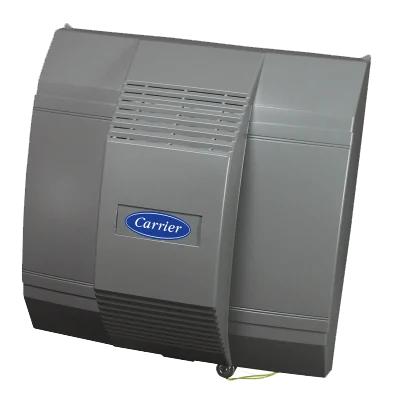©2025 BloomfieldCooling.com. All Rights Reserved. | Privacy Policy | Sitemap | Powered by Media Consultants, LLC



Ah, winter in northern New Jersey. Your windows are shut tight, the doors have sweeps and insulation, the heat is keeping your home cozy. All well and good—but how is the quality of your indoor air?
Without the exchange of fresh air that naturally happens when windows are open, it can get stuffy in the house. Plus, with an airtight home (especially newer homes that are not as “leaky” as older ones), airborne allergens such as dust, dander and mold, and pollutants such as those emitted from aerosol sprays or VOCs (volatile organic compounds) from paints or furniture, can become trapped. If you use a wood-burning stove or fireplace for supplemental heat or for ambiance, these also throw off pollutants and lots of CO2 as a result of combustion—both of which are dangerous when inhaled.
Many people are sensitive to these particles, including the elderly, young children, or those with respiratory conditions, so improving the quality of your indoor air is important. Here are some ways to do so.
1 – Buy some greenery – indoor plants exchange carbon dioxide for oxygen and are natural air purifiers, as their leaves absorb impurities from the air. They brighten up the place as well!
2 – Keep floors and surfaces clean – leave shoes at the door to avoid tracking bacteria from outside, mop hardwood floors with a white vinegar/water mixture to remove surface dirt and pollutants, and vacuum carpets with a vacuum cleaner equipped with a HEPA filter. It’s a good idea to also vacuum upholstery and drapes, where dust and dirt collect.
3 – Avoid artificially scented products – many commercial scented candles are made with chemicals you shouldn’t be inhaling; soy or beeswax candles are often scented with essential oils. The same goes for room fresheners—look for brands that use natural oils, not chemicals.
4 – Clean with “green” – eco-friendly cleaning products are easy to find and foster a healthier indoor environment. Look online for tips on how to make your own from vinegar and baking soda.
5 – Use low-VOC products – make sure those home improvement projects aren’t doing more harm than good. If you’re painting a room or doing some construction, look for products with low levels of volatile organic compounds.
6 – Ventilate – sure it’s cold out but open the windows now and then or turn on fans to refresh the air and let out pollutants.
7 – Humidify – that dry winter air can aggravate allergies and asthma, harm antiques and collectibles (and your furniture), and irritate skin. Installing a whole-home humidifier on your forced hot air system keeps indoor humidity at the perfect range of 50-60%. Youi can also add moisture to the air in some easy DIY ways, such as line-drying your laundry, letting dishes in the dishwasher air dry (open the door after the rinse cycle is done to release steam into the air), let the shower or hot bath water moisturize the air, and cook more often on the stovetop rather than use the oven.
8 – Install in-duct air purification – at Bloomfield Cooling, Heating & Electric, we install three in-duct devices that purify and sanitize your indoor air, ridding it of airborne pathogens 8 -8 such as viruses and bacteria, plus mold, fungi, dust and other irritants. These are the REME HALO, iWave, and Blue-Tube UV—different technologies that inactivate (among other things), the SARS-CoV-2 virus. We also install industry-leading whole-home air purifiers as well as air filtration solutions to meet every budget.
Here’s another tip—take advantage of our special installation offer and save $100 on the installation of any of our air purification solutions for your home. You’ll find all the information and the offer at https://bloomfieldcooling.com/services/air-quality/. Contact our office at 973-237-0505 to set up your consultation and bring cleaner, healthier air into your home.